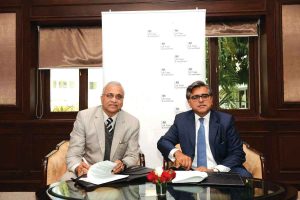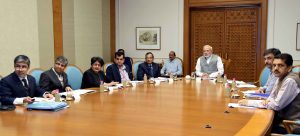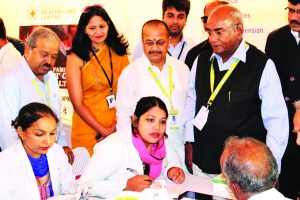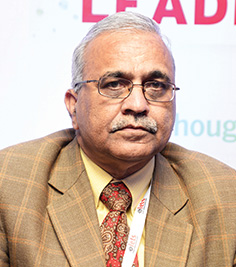Distinguished Contribution In Innovating Quality
 Dr Girdhar J. Gyani, Director General, Association of Healthcare Providers (India) is well known personality in medical fraternity for his distinguished contribution in innovating quality in industry including Education and Healthcare. Double Helical explores his profile for his outstanding contribution to get global recognition of 200 leading hospitals in the country……..
Dr Girdhar J. Gyani, Director General, Association of Healthcare Providers (India) is well known personality in medical fraternity for his distinguished contribution in innovating quality in industry including Education and Healthcare. Double Helical explores his profile for his outstanding contribution to get global recognition of 200 leading hospitals in the country……..
By Amresh K Tiwary
Dr. Girdhar J. Gyani has distinguished himself in being a rare quality professional that has made break through contribution in the advancement of quality in all fields of industry and public services, ranging from manufacturing industry, healthcare, education, governance, vocational training and government services, all at apex level.
In short span of 9-years, Dr Gyani has virtually transformed quality scenario of the country all aimed at National Well Being. He has raised Quality Control of India (QCI)to a level, where it is playing a key role in facilitating quality as national framework for vast canvass ranging from manufacturing, education, skill development, environment, healthcare and governance (public services), benefiting Indian Trade & Industry on global platform.
Dr Girdhar Gyani held the prestigious assignment as Secretary General, Quality Council of India (apex quality body of country) during 2003-12. He was assigned with the responsibility for establishing & operating national accreditation structure and promoting quality in all walks of life. Starting with a team as small as four members, Dr. Gyani has the rare distinction of serving as elected director on board of International
Accreditation Forum (IAF) for 6-years (2004-10). He has worked extensively on improving effectiveness of quality certification process through actual field validation, findings of which have appeared in prominent international quality journals. He is widely travelled and has been invited speaker at several international seminars on quality.
He has been promoting using of third party conformity assessment structure to improve regulatory quality and in turn effectiveness in governance with the motto; “Quality for National Well Being” His contribution in developing accreditation scheme for Environment Impact Assessment (EIA) for the first time in the country has been widely appreciated by government as well as by industry.
Likewise he has contributed great deal in promoting quality in Food Safety in close association with Ministry of Food Processing Industry and Food Safety Standards Authority of India.
Dr Gyani has been lead faculty for large number of QMS LA courses. He also has been lead faculty for Laboratory Assessor courses for National Accreditation Board for Test & Calibration Laboratories (NABL). Dr Gyani has been ASSESSOR for both the accreditation boards i.e. NABCB (MLA member of IAF) and NABL (MRA member of ILAC) as per ISO 17011.
One of his towering contributions has been in establishing and operating national accreditation structure (NABH) for healthcare for the first time in the country and where he worked as its CEO till he superannuated in July 2012. The accreditation program covers hospitals, nursing homes, blood banks diagnostic centers and clinics.
The standards have helped about 200- leading hospitals in the country to get global recognition and in turn providing boost to medical tourism. He has also helped number of state governments in improving quality in public health establishments like district hospitals and Primary Health Centers (PHCs) through capacity building measures. This includes states like NCT Delhi, Kerala, Tamil Nadu, Gujarat, J&K, Haryana, and Punjab. This resulted in much needed improvement in patient safety indicators in these states.
He was inducted as member of Academic council of Medical Council of India (MCI) to improve the assessment process for medical colleges. He has distinction of being first Indian to have served as elected director on board of International Society for Quality in Health care (ISQua) for year 2009-11 and again for 2011-14, which is great honour for the country.
In the area of education, based on the task assigned by Dr APJ Abdul Kalam, then President of India, Dr Gyani has the distinction of evolving for the first time in the country, the quality accreditation standard for schools which defines quality governance in schools for providing holistic development of students. The standard has been adopted by Schools affiliated to Kendriya Vidyalaya Sangthana (KVS). The standard has also been adopted by governments of Maharashtra, Bihar, Sikkim and Assam. All these measures will have far reaching effect on quality of education in government schools. He has also been instrumental in evolving similar standards for vocational training institutions and for skill assessment bodies, with a view to having skilled/employable work force in the country, in line with target set by PMO. The standard has been adopted by Ministry of Labour as essential criteria for affiliation of new Industrial Training Institutes, once again raising quality of vocational training in the country. He has also played key role in establishing bilateral agreements with countries like Scotland (UK), Germany and Australia in recognising vocational education programs, which will help cross migration of skilled work force and thereby providing boost to Trade & Industry.
His long cherished mission has been to take quality to grass root levels and he got the opportunity to translate this by developing unique Quality criteria for quality governance of GRAM PANCHAYAT (GP) and put it in practice in 104 GPs in the state of Karnataka. This is going to have far reaching impact in empowering society at grass root. Dr Gyani was felicitated by Mr Sadananda Gowda, Hon Chief Minister of Karnataka for this incredible initiative.
Dr. Gyani holds Doctorate degree in Quality. He has been conferred with 16th Lal C. Verman Award in year 2002 in recognition with distinguished contribution in the field of standardization, precision measurement & quality control. He is recipient of Rotary Centenary Award in year 2004 for Excellence in the field of Quality.
Association Of Healthcare Providers (India)

INTRODUCTION:
Association of Healthcare Providers (India) represents the vast majority of healthcare providers in India. It is registered under Society Registration ACT- 1860 as “not for profit” organization. It educates to its members and at the same time, advocates with the government, regulatory bodies and other stake holders on issues, which have bearing on enabling its member organizations in delivering of Universal Health Coverage to the community at large. AHPI has been working on building capacity in Indian health systems with focus on patient safety and affordability of healthcare services.
AHPI was formally rolled out in October 2012 as a voice of the healthcare industry. Till AHPI was formed, there was no pan India association for healthcare providers. Right from the beginning, we have been functioning as ‘not for profit’ organisation that wanted to engage with the Government and other stake holders to participate in health policy formulation and execution. We chose the motto of AHPI as: ‘Educating and Advocating for Well Being of Common Man’
AHPI in a way is unique that we do not charge membership fee. Some of our patrons generously donated money for our operations for the first couple of years.In the past three years, we have not drawn any major donation as we generate revenue through our activities including organizing of events and training programs. AHPI today is self-sustainable organization.
GOVERNING STRUCTURE:
AHPI as mentioned above is registered as society. It is governed by Governing Body, which comprised of eight founding members drawn from seven states to make it PAN INDIA society. In order to engage hospitals effectively,there are 14-state/regional chapters covering entire India, with each chapter having its president, secretary and members as part of state executive committee. Each state chapter committee has three sub-committees, each working on (i) advocacy, (ii) education and training and (iii) public engagement. State committees regularly hold meetings in different districts of state. President of each chapter gets nominated as member in central executive (governing) committee. This makes AHPI as true representative body pan India.
ACHIEVEMENTS:
Quality Empanelment: AHPI joined hands with NABH in pursuing IRDA to make NABH accreditation mandatory for all hospitals wanting to get TPA empanelled. This has generated big push towards quality and patient safety in the country.
Electricity Tariff:AHPI worked with the Government to reduce electricity tariff for healthcare institutes to make healthcare more affordable. The electricity cost is Rs 700 to Rs 800 per day per bed for a tertiary care healthcare institute. Karnataka government was first to act and reduce tariff by 15%. Based on this other state governments have initiated similar steps.
Clinical Establishment Act: In a major step,AHPI successfully persuaded government of Karnataka not to include cost of individual procedures in the recently released Clinical Establishment ACT. It may be relevant to mention that till date no agency has worked out costing of medical procedures and therefore fixing of rates without any scientific basis would have proved disaster and made hospitals un-sustainable and also would have compromised on patient safety.
Medical Procedure Costing: AHPI initiated a unique costing study under the aegis of Government of Karnataka with key members like IIM (B), NABH, CMC Vellore, Medical Department of ISRO etc. This study was based on clinical pathway methodology to arrive at actual cost incurred for 20-selected procedures. The study showed that reimbursement under various government health insurance schemes i.e. CGHS, Yashasvini and Vajpayee Arogya Shree, fall short of actual cost of medical procedures by huge margin. It also showed that different government schemes have different rates for the same procedure.
Increase in PG seats/CPS: AHPI has worked to pursue MOHFW and MCI to address shortage of specialists. India is producing 63,835 MBBS graduates every year but have less than 25000 PG seats. Country like USA on the other hand has 40,000 PG seats as compared to 20,000 UG seats. Government alone employs 65,697 MBBS doctors, whereas specialists’ vacancies are reported to be more than 80% in community health centers (CHCs) alone. With such a scenario,we cannot improve on health indicators including IMR/MMR. AHPI right at the time of inception in year 2012-13 launched movement; ‘Equal PG-UG seats’ to draw attention of government to increase PG seats. With the result, MOHFW have increased some seats, but these were not going to be sufficient. With tiring efforts put in by AHPI under the leadership of Dr Devi Shetty, Government has now recognized diploma courses of CPS, which will meet the shortage of specialists in next 3-5 years.
Support to Medical Tourism: There have been many complaints about medical tourism patients being cheated by facilitators. This was adversely affecting image of Indian hospitals, without their involvement. AHPI along with other industry bodies, initiated the subject with Ministry of Commerce to have an empanelment scheme to accredit Medical Value Travel Facilitator, under which six facilitators have been accredited under the scheme by NABH. Their names are available on NABH web site. Ministry of Commerce is actively promoting the concept through diplomatic channels. AHPI is actively engaging the member hospitals to promote the concept.
Ministry of Commerce is also working on ambitious project involving export of trained allied health workforce. AHPI in association with MOHFW and IGNOU are working on training of various categories of allied healthcare workforce to meet demand within the country as well as in export of such services. Overall aim is to provide boost to skill based employment. AHPI will make available their member hospitals in training of this workforce.
NHPS/ AYUSHMAN BHARAT: NDA government under the leadership of Prime Minister has announced to accord priority to health and has announced government health insurance scheme with cover of 5-lakh for BPL families.This is going to be biggest health insurance scheme anywhere in the world as it would target nearly 40% of 1.25 billion populations. The scheme has been named as ‘Ayushman Bharat Scheme’. As public health system is not adequate, the scheme will also provide spur to opening of new hospitals in tier-II and tier-III cities. AHPI is gearing up in facilitating member hospitals in empanelment in the scheme. AHPI has submitted pricing details of some of the procedures to MOHFW and has strongly recommended to fix prices of procedures scientifically, without which many hospitals will not be able to come forward to be part of this ambitious scheme.
Capacity Building in Health Systems: Healthcare industry has two challenges; one is ensuring patient safety and second is making healthcare affordable. AHPI is constantly working on enabling members to meet these twin challenges. AHPI Institute of Healthcare Quality has launched series of short term training programs.Four of these programs have been endorsed by West Bengal University of Health Sciences. These include; certified infection prevention and control nurse, which for first time introduces concept of deploying Link ICN for each nursing station. AHPI has developed standard for Green & Clean Hospitals, which was endorsed by Hon Ministers for Health and Environment. The standard has now been adopted as certifiable standard by globally acclaimed quality certification body; BVCI for Indian market. AHPI has also facilitated BVCI in developing unique standard for certifying ICUs. Considering that most ICU patients get infected via ventilators and other means, this is going to be of big help in containing hospital acquired infection. The standard has been endorsed by Indian Society for Critical Care Medicine (ISCCM). In a very significant initiative, AHPI collaborated with ISRO to adopt their best practices in terms of quality in to health sector. Tow pilot projects for (i) critical care medicine and (ii) emergency medicine have been successfully completed.
Adult Vaccination: AHPI has prepared ambitious project on promoting ADULT VACCINATION. There are 11-vaccinations, which are recommended by CDC but are hardly known in our country. AHPI is shortly going to launch this program, aimed at protecting vast segment of venerable population form variety of diseases/epidemics.
AYUSHMAN BHARAT: A Game Changer

Looking at sheer size and quantum of work load, it would be imperative that resources available with public and private sector are pooled, utilized and managed to achieve the desired goals; under the overall gambit of universal health coverage (UHC)….
By Dr Girdhar J. Gyani
Recently Government of India in its budget proposals for year 2018-19 has come out with some of the land mark initiatives. These include National Health Protection Scheme (NHPS) and opening up of 1.5 lakh health & wellness centres. The government has announced to launch 1.5 lakh Health & Wellness Centres (HWC) to bring promotional, preventive and primary health care system closer to the homes of people.
These centres will provide comprehensive health care, including for non-communicable diseases and maternal and child health services. These centres will also provide free essential drugs and diagnostic services. The Budget allocation for this flagship programme is Rs 1200 crore. Contribution of private sector through CSR and philanthropic institutions in adopting these centres is also envisaged.
 Considering that we have about 1.5 lakh sub-centres available, it will be in fitness of things that these sub-centres are upgraded into HWCs which are closest to the community. The first point of referral for such HWCs in normal course would be nearby existing PHC/ CHC to provide the package of comprehensive primary health care. It will have further linkages with the district hospitals and tertiary care teaching hospitals. For sub-center to be an effective in the new role of HWC, re-engineering of existing structure and resources will be required to enable it to provide comprehensive primary care including; Maternal Health Care Services, Neonatal and Infant Health Care Services, Management of Communicable and Non-Communicable Diseases along with necessary diagnostic services etc.
Considering that we have about 1.5 lakh sub-centres available, it will be in fitness of things that these sub-centres are upgraded into HWCs which are closest to the community. The first point of referral for such HWCs in normal course would be nearby existing PHC/ CHC to provide the package of comprehensive primary health care. It will have further linkages with the district hospitals and tertiary care teaching hospitals. For sub-center to be an effective in the new role of HWC, re-engineering of existing structure and resources will be required to enable it to provide comprehensive primary care including; Maternal Health Care Services, Neonatal and Infant Health Care Services, Management of Communicable and Non-Communicable Diseases along with necessary diagnostic services etc.
Reference to the Health & Wellness Centers was made in the national health policy released on 15th March 2017. Few states including Haryana, Punjab and J&K are known to have initiated converting some of their sub-centers in to HWCs. Haryana & Punjab governments have planned to train community health officers, who would manage these centers, with specialist doctor from nearby PHC or CHC visiting HWCs on regular basis.

Role of Private Sector: Private sector has huge opportunity by adopting few sub-centers as HWCs. AHPI has proposed to the government that its member hospitals will be willing to manage some of the HWCs within the same budget, which government provide for existing sub-center. The manpower would be fully deployed by the private sector provider, with provision of specialist doctor visiting on need basis from main hospital or consulting through telemedicine as appropriate. Entry of private sector in a way will also generate healthy competition as well as cooperation between public and private sector. Some of the additional suggestions for effective functioning of proposed HWCs are appended below:
1- Maintenance of electronic family file for every house in the community should become integral part of proposed HWCs, so that community statistics is adequately monitored and whenever required corrective steps could be taken. There should be a separate division/agency to conduct community surveys to keep track of life style diseases, infections, immunization and other illnesses and advice people on life style changes which are required.
2- Maternity and child welfare schemes are very important. Birth and death registers and wedding registers are important. Support will be required for early diagnosis of pregnancy and managing the expectant mothers throughout their difficult times.
3- Creating specialty clinics in some of the most underserved areas of the country as per local requirements for specific disease/epidemic control, where doctors could visit these centres on a periodic basis engaging in both treatment and preventive care.
4- There is a requirement for leveraging technology. Telemedicine services can be effectively utilized to connect remote areas withTaluk& District Hospitals, in view of the scarcity of qualified doctors. With good penetration of mobiles in the country, this should be easily possible. There is a requirement for having paramedical staff to provide primary care in rural areas as there is a huge gap in the availability of doctors/nursing staff. More healthcare workers should be given training and certification to treat minor illnesses.
5- Use Technology to drive positive healthcare outcomes – App based Remote Monitoring Technologies for creating awareness and improving treatment/management of chronic conditions (home health care)wherever frontline healthcare workers are involved, use digital connect to transform them into “knowledge supervisors”. This, by way of imparting “Skill training” through an innovate combination of smart phones and web based technologies to train the healthcare workers in areas. We can bring the entire radio imaging (besides ultrasound) on to an electronic/cloud based platform.
6- It will need emphasis on clean model environment in a health & wellness centre in line with Prime Minister’s ‘Clean India Campaign’. Supply of clean water, 24X7 electricity, clean linen and good clean examination room for patients should be basic elements. It will also require all round maintenance of facility along with un-interrupted Wi-Fi connection.
7- Government should progressively aim at adequate space around HWC (10-acre campus) so that staff could be provided with living quarters to look after emergencies.

National Health Protection Scheme: This is flagship programme under AYUSHMAN BHARAT, which will cover over 10 crore poor and vulnerable families (approximately 50 crore beneficiaries) providing coverage upto Rs5 lakh per family per year for secondary and tertiary care hospitalization. This will be the world’s largest government funded health care programme. Adequate funds will be provided for smooth implementation of this programme.
If there were adequate public sector hospitals, then scheme could have been delivered through network of CHCs, District Hospitals and government teaching hospitals. But considering that about 60% IPD beds are with the private sector, it is inevitable that private sector will havean important role in NHPS. The scheme however should ensureself-sustenance of hospitals. We have experience of operating central government insurance schemes like CGHS, ECHS, ESIC, RSBY etc. Similarly there are state government sponsored schemes in states like; Andhra Pradesh, Telangana, Tamil Nadu, Maharashtra, Himachal Pradesh, Gujarat, Rajasthan and Karnataka etc. There are enough success/failure lessons from these schemes, which could be made use of in designing near perfect model to deliver NHPS. Some of the suggestions are appended below;
1- REFERRAL MECHANISM: NHPS’ success will critically depend on strengthening of 1.5 lakh Health and Wellness Centres, which will not only help in lowering incidence but also serve as a strong Gate Keeper to appropriately channelize referrals for secondary and tertiary procedures. Government may consider putting together a ‘negative list’ of procedures that should strictly be treated only in the public hospitals
2- EMPANELMENT OF HOSPITALS: World over, quality and patient safety in healthcare is driven either through regulation or by PAYERS. NHPS being government run insurance scheme, it should be imperative that Patient Safety must be key consideration while empanelling of hospitals. NHPS as a rule should not empanel any hospital unless it has been verified based on established minimum criteria on quality/patient safety. Some of state run insurance schemes have made Entry Level NABH certificate as minimum criteria for empanelment. We have about 650-hospitals accredited by NABH. Then there are 700-hospitals which are certified under entry level standard by NABH. To begin with this number (650+700) can become critical mass of empaneled hospitals. In case there is need to rope in more hospitals, these can be provisionally empaneled based on defined structural criteria (in terms of number of beds/specialties etc.) as decided by MOHFW, with condition that they will obtain at least entry level certification by NABH within 1-year. In time to come, we may implement ‘pay for performance’ model where reimbursement is linked to clinical & managerial outcomes.
3- FIXING OF RATES: It is unfortunate that no scientific study has been done till date to compute actual costing of delivering variety of medical procedures under different settings. It will be appropriate that MOHFW should endeavor on urgent basis to ascertain the actual costs to private hospitals in rendering services to beneficiaries under NHPS. Government may institute an independent agency with representatives from IIM, cost accountants from professional consulting companies, major hospitals and insurance companies to carry out a costing study, which may find out the cost of delivering healthcare in a model hospital. By using appropriate factor, these costs could be computed for various settings/categories of hospitals based on geographical location, size, level of specialty, status of accreditation etc. Scheme may also decide what procedures should be referred to which category of hospitals to ensure safety as well as optimum and cost effective utilization of the hospital network. Over and above patients can be given option for co-payment in case they want to upgrade the level of care – for example pay extra out of pocket for private room or extra for FDA implants as required. The rates fixed once, should be subjected to periodic revision. As incentive for quality, the rates for full NABH accreditation could be fixed at 15% higher than rest.
4- ON-LINE PAYMENT/TRACKING: The NHPS system should be digitized, where hospitals can submit bills ON-LINE and even the payment should be made ON-LINE. The payment should be reimbursed in time bound manner. For example, 50% money could be transferred within 10-days of submission of bills. Balance 50% could be transferred within next 20-days. In case of delay, there should be provision to pay interest; this aspect is important as present schemes have failed largely on this account that payments are delayed for months. State government schemes like in TN, TELANGANA and AP have transparent and efficient system of digital tracking of patients and treatment line, which can be studied and adopted for NHPS. AROGYA MITRA is good concept as has been in practice in TN-CM scheme.
5- Grievance Redressal: It is important that NHPS has built-in grievance redressal mechanism, which can listen grievances from beneficiaries as well as from empaneled hospitals. While beneficiaries will have grievances from treating hospitals, the empaneled hospitals will have grievances mainly on account of delay in payment and some time the un-accounted deductions from the submitted bills. Both are important to be addressed for long term success of scheme.
6-Patient Verification: The scheme as we know is for those, who are part of SECC (Socio Economic Caste Census) list and has an Aadhaar number, as enrolled. This would eliminate all malpractices/inefficiencies observed on ground during enrolment. Further, the enrolled members should be on a name basis rather than generic family name of 1+4. This would avoid impersonation and frauds on the ground. In case one is part of SECC list but does not have Aadhaar, provide clear guideline for alternative ways of identification to avoid any issues with reimbursements later.
7- Scheme Regulator: NHPS may designate an independent Quality regulator, who would lay out clear guidelines with respect to re-use of single use device, use of generic medicines etc. applicable for all empanelled providers under the scheme so as to enable delivery of quality services at an affordable cost. An appropriate medical audit system to be in place
CONCLUSION: It is first time since independence that government has come with bold initiative with focus on healthcare. As mentioned above NHPS is going to be world’s largest UHC scheme. All efforts therefore must be channelized to make it happen. Once we succeed, it will revolutionaries the complete health delivery systems in the country. World is keenly awaiting to see how such a mega scheme is rolled and sustained. It is going to be boon for BPL families to mitigate serious illness cases. It will also give boost to healthcare industry, which is passing through anxious moments due to sustainability issues. All in all it should be exciting journey which hopefully will open up road to happy and healthy India.
(The author is Director General, Association of Healthcare Providers, India)

